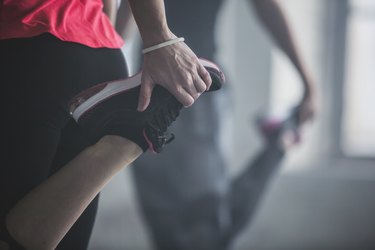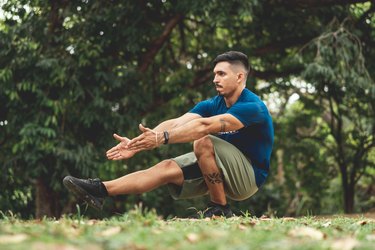
Maybe you've tried clamshells or crab walks in the past. Now, you can add another nautical exercise to your workout aquarium: the shrimp squat.
- What is a shrimp squat? It's an exercise that involves holding the top of one foot behind you while squatting down with the other.
- What muscles does a shrimp squat work? This is a lower-body body-weight exercise that strengthens your quads, glutes, hamstrings and core, according to Jereme Schumacher, DPT, a California-based physical therapist.
- Who can do this exercise? This exercise is very challenging on your joints and range of motion, lowering with one leg behind you, he says. Anyone with previous injuries, knee pain or mobility limitations should probably avoid this exercise.
- How does a shrimp squat compare to a Bulgarian split squat? Both of these unilateral (single-sided) squat variations involve While, in a shrimp, you hold onto your raised foot, in a Bulgarian split squat, your back foot rests on a bench or box. That makes shrimps the more difficult move.
Video of the Day
How to Do the Shrimp Squat With Perfect Form
Shrimp Squat
- Stand with your feet close together.
- Transfer your weight onto one foot, bend the other behind you and grab your raised foot with that side's hand. Hold your other arm to your side for balance.
- Bend the knee of your planted leg and push your hips back to lower as far as comfortable.
- Press through your left foot to return to standing.
Tip
Lean your trunk slightly forward to stay balanced in the move, Schumacher says. You can also place a cushion on the floor to act as a just-in-case buffer between your knee and the floor.
4 Next-Level Benefits
This advanced body-weight squat variation is incredibly hard. But its benefits are just as great.
1. Lower-Body Strength
The biggest advantage of this exercise is its lower-body strength building benefits, according to Schumacher. As you lower, your quads and glutes work eccentrically (lengthening) to control your descent. As you stand back up, those muscle groups have to forcefully contract.
Meanwhile, the whole time, your hamstrings and core work to stabilize and smooth out the movement.
2. Improved Balance and Stability
All single-leg exercises help build balance and stability, but this one can challenge even the most well-balanced folks.
The deeper you lower into the squat, the greater the temptation to wobble. That said, don't worry if you do shake or lose your balance at times. As you gain practice, your stabilizer muscles will rise to the challenge.
3. Evened-Out Muscle Imbalances
When you do exercises like dumbbell deadlifts, both sides of your body work together to lift the weights. But considering everyone is stronger on their right or left, it's inevitable that one side does more work than the other. In the long run, this may create muscle imbalances across your body, which can lead to injury, according to Schumacher.
Single-leg or single-arm exercises (aka unilateral exercises) like this one can help even out imbalances across your body, according to the American Council on Exercise (ACE). Without the ability to rely on your dominant leg, you build more strength on your less-strong side.
4. Improved Mobility
As your one side works to lift and lower your whole body solo, the exercise demands a lot of mobility from your hip and knee joints, according to Schumacher.
Start with the range of motion that works best for you and, over time, you will likely be bend your hips and knees farther.
2 Shrimp Squat Modifications to Help You Work Up to the Move
And advanced squat variation, the shrimp isn't always something everyone can do on day 1. But, with these tips, you will in time.
1. Assisted Reps
The simplest way to go is to place one hand on a sturdy piece of furniture or counter. This will help you better balance, so your muscles have one less thing to do.
You can also use a TRX to help pull yourself up from the bottom of the motion. With this modification, you hold the straps and use them you stabilize and raise up.
Tip
If you don't have a TRX handy, try using a long-loop resistance band (Amazon.com, $14.99) anchored above your head.
2. Shallow Reps
Another modified version involves shortening the distance you lower to the ground, Schumacher says. Start by lowering only a few inches and increase the depth over time.
You can even combine your shallow squats with a TRX, resistance band or countertop assist.
2 Shrimp Squat Progressions for Continued Gains
Once you master the shrimp, keep on building strength with these advanced variations.
1. Tempo Reps
Slowing down the lowering (aka eccentric) portion of the move is a simple way to make this exercise way more challenging. Lower toward the ground for a 3-second count, pause briefly at the bottom and stand back up.
2. Weighted Reps
Instead of grabbing your rear leg with two hands, use only one. In the other, hold a dumbbell or kettlebell. This will add a little extra resistance, making your muscles work that much harder, Schumacher says.
Was this article helpful?
150 Characters Max
0/150
Thank you for sharing!
Thank you for your feedback!


